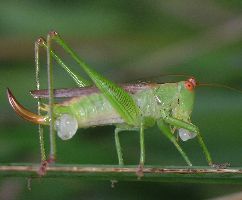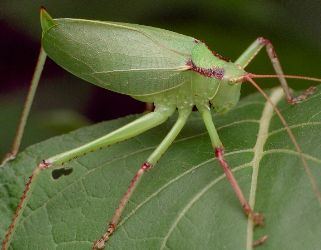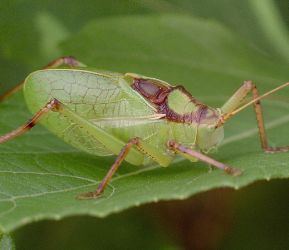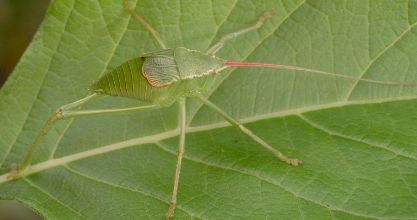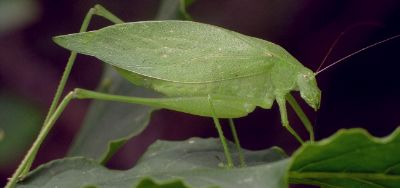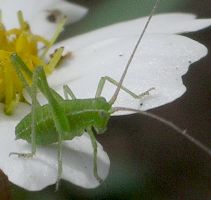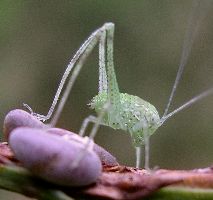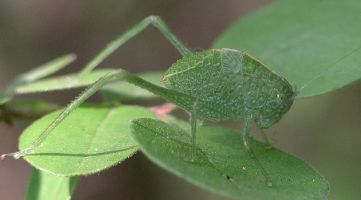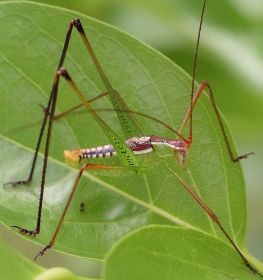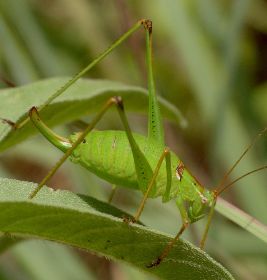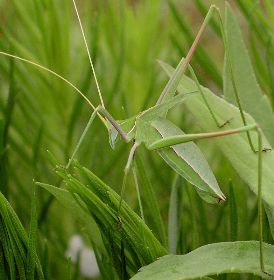
| Tettigoniidae ~ Katydids |
|
Members of this family are sometimes commonly called long-horned grasshoppers, but katydids are more closely related to crickets. This is one insect group where the sounds of the males calling to females are as useful for identification as bird or frog songs. Katydids are generally large insects but they also employ camouflage to hide from predators, so the songs are heard more often than the animals are seen. It is possible to hear katydid songs on the internet but audio files are beyond the scope of this site so I will concentrate on visual identification.
Gender is easy to determine on adult katydids, and even older nymphs. The females have an ovipositor, which might be straight, curved, rounded or flat. In some cases it can be very long. Males, of course, lack this structure, but they usually have distinctive shortened appendages (cerci) on their rear that help in identification of different species. The males have modified wings for singing, with the part at the top just behind the pronotum producing the sounds. This area often looks sort of swollen or bumpy. Even the males of short-winged species have enough there to produce their calls. Katydids produce their songs by means of stridulation: rubbing a file-like structure of one wing against the scraper of the other to make trilling, chirping, or buzzing sounds. When males sing, it looks like their wings puff up just a bit and vibrate like crazy. They tend to stop singing if they feel threatened, so it is necessary to sneak up on them to watch. The ears of katydids are located on their front legs, and are easy to see on large individuals.
Mating appears to be quite secretive in katydids, unlike grasshoppers, which are often found coupling. I've never managed to catch a pair of katydids in the act. However, when they mate, the male transfers a large jelly-like mass called a spermatophore to the female. This has two parts: a small packet of sperm which is inserted into the female followed by a larger glob of nutritious gel, a nuptial gift that the female consumes to help with egg production. This white glob is easily seen attached to recently mated females. The eggs of katydids are not commonly found. They are sometimes buried in soil or inserted in leaves and stems of plants. However, the eggs of some species are laid in rows on the surface of twigs. The only katydid eggs I've encountered are probably those of the Greater Angle-wing (Microcentrum rhombifolium) but I don't know if other related katydids' eggs look similar. These look like flattened gray oval buttons aligned in two rows along a tree twig. When the eggs hatch, they open like an oyster, separating at the seam along the edge. Empty eggs resemble a row of little bivalves. Sometimes I've found these eggs with a circular hole in the center of each one. Since the eggs do not hatch in this way, I can only deduce that a predator of some kind ate the contents.
There are a number of katydid species in our area and they are placed in various subfamilies. Only one member of the true katydids occurs here and that is the Truncated True Katydid (Paracyrtophyllus robustus). This is a very localized species; it is also called the Texas Leaf Katydid. The much more widespread Common True Katydid (
Truncated True Katydids are very large and wide. They are about 35-40 mm long and their bluntly rounded wings fold around their bodies like clam shells. Color is green with brown markings and they certainly blend in well with tree foliage, which is where they are normally found. I don't think they can fly with their short wings, as I've never seen any attempt to do so. Their thin legs are better adapted for clinging to branches than for hopping and they hardly move when threatened, usually simply remaining perfectly still. The tip of the female's curved ovipositor sticks out a little between the wings, while the males have more extensive brown markings on the stridulating part of their wings. The head is large, with beady little round eyes. Nymphs of this species are pretty distinctive.
Another subfamily goes by the name of false katydids. There are several genera of this group in our area. The Texas False Katydid (Amblycorypha huasteca) is, as its name implies, found throughout the state. It is large (about 45-50 mm long), flattened and green, and does an admirable job of resembling a leaf. The head is quite small and pointy, and the eyes are oval shaped. This katydid will fly sometimes when threatened, but more often seems to want to just stay put and hide.
The Oblong-winged Katydid (Amblycorypha oblongifolia) looks almost exactly like the Texas False Katydid and is about the same size. The biggest difference is in the length of the curved female ovipositors. That of the Oblong-winged Katydid is shorter and never extends above the wings, while the Texas False Katydid has a long ovipositor that always sticks out either between the wings or to one side. Other differences I've noticed are harder to distinguish, such as the more glossy texture of the Oblong-winged Katydid, and a slightly different shape along the top margin of the wings.
I find that the Greater Angle-wing (Microcentrum rhombifolium) is very easy to confuse with Amblycorypha species. Both are large, flattened, and leaf-shaped. The best way to distinguish the Greater Angle-wing, though, is by the way it holds its head. Instead of the tip of the head pointing outwards, M. rhombifolium tends to tuck its snout underneath. Other Greater Angle-wing features that help identify it are relatively short hind legs, more pronounced whitish veins and spots on the wings, and round instead of oval eyes.
Nymphs of the genus Amblycorypha are chubby little green jobs with long legs, but their oval slanted eyes will separate them from both Microcentrum and Dichopetala, which look rather similar when very young.
The nymphs of the Greater Angle-wing (Microcentrum rhombifolium) are actually pretty easy to recognize. They have a sharp ridge along their back that is lacking in any similar species, as well as a very mottled appearance and round eyes.
The adult Spoon-tailed Short-winged Katydids are easy to recognize, although they may vary a bit in color and pattern. They are 20-30 mm long, with very lanky legs. Males pretty much always look similar, and their shape is quite different from the females, which are round and hump-backed. The "spoon-shaped" tail bits of the male are a bright yellow and the back is marked with brown and white. Females can be almost all green or have extensive dark markings down their back. I'm not sure if it might be a maturity thing, as the final nymph instar is almost as big as an adult female, and the fact that the wings are mere stubs doesn't help distinguish a fully mature individual. Besides lacking flight wings, these heavy-bodied katydids do not even seem to use their legs much for jumping, and instead tend to move slowly and rely on camouflage for protection.
Perhaps the freakiest looking katydid is the Walking Thread-legged Katydid (Arethaea ambulator). It has such impossibly long legs that it seems remarkable they can bear weight at all. The common name must have been created by a taxonomist, as it refers to the Latin species name. Of course any insect with short and non-functional wings and legs too spindly to jump will be walking. How else would they get around? This is not a very common species here, and I've only seen it once.
|
![]()
